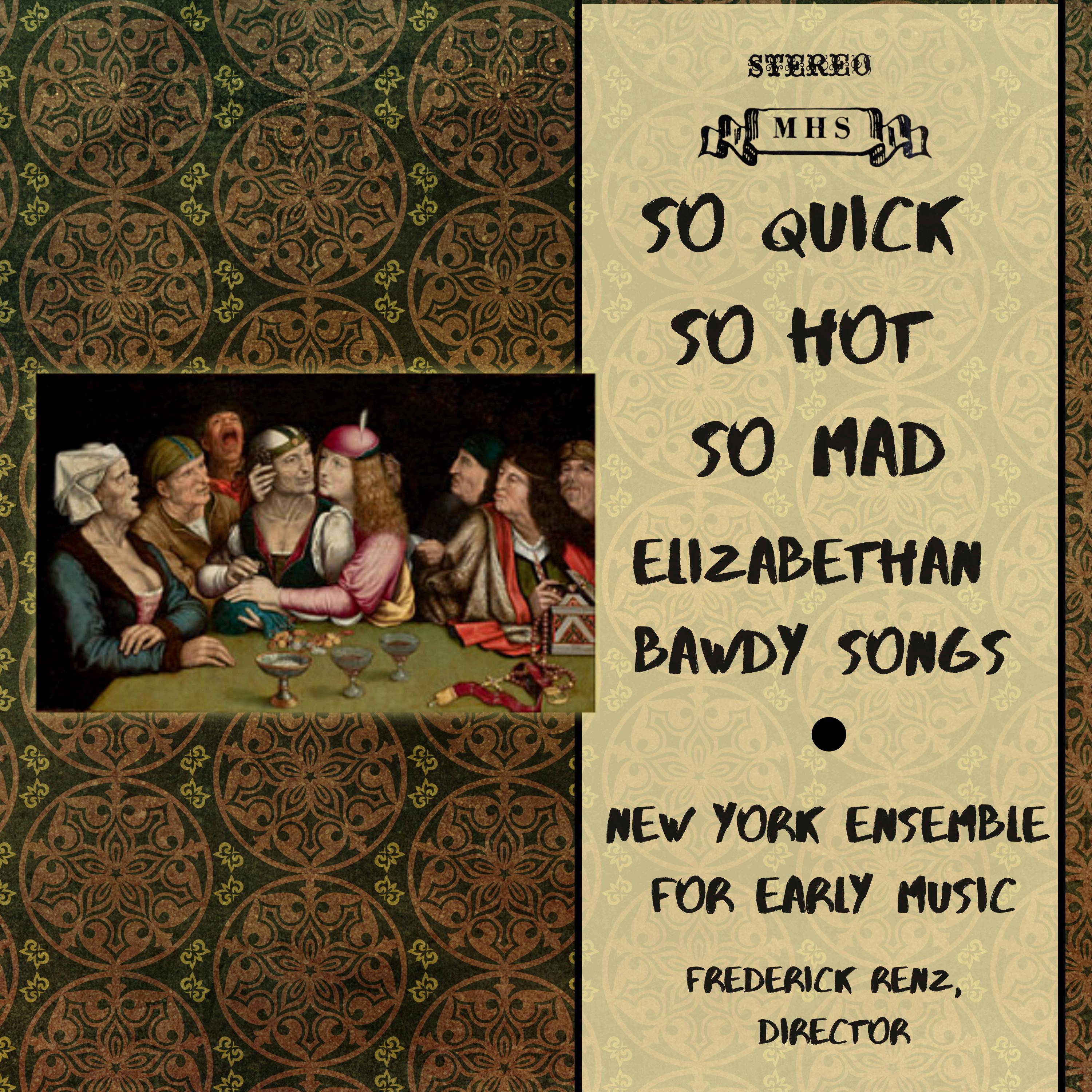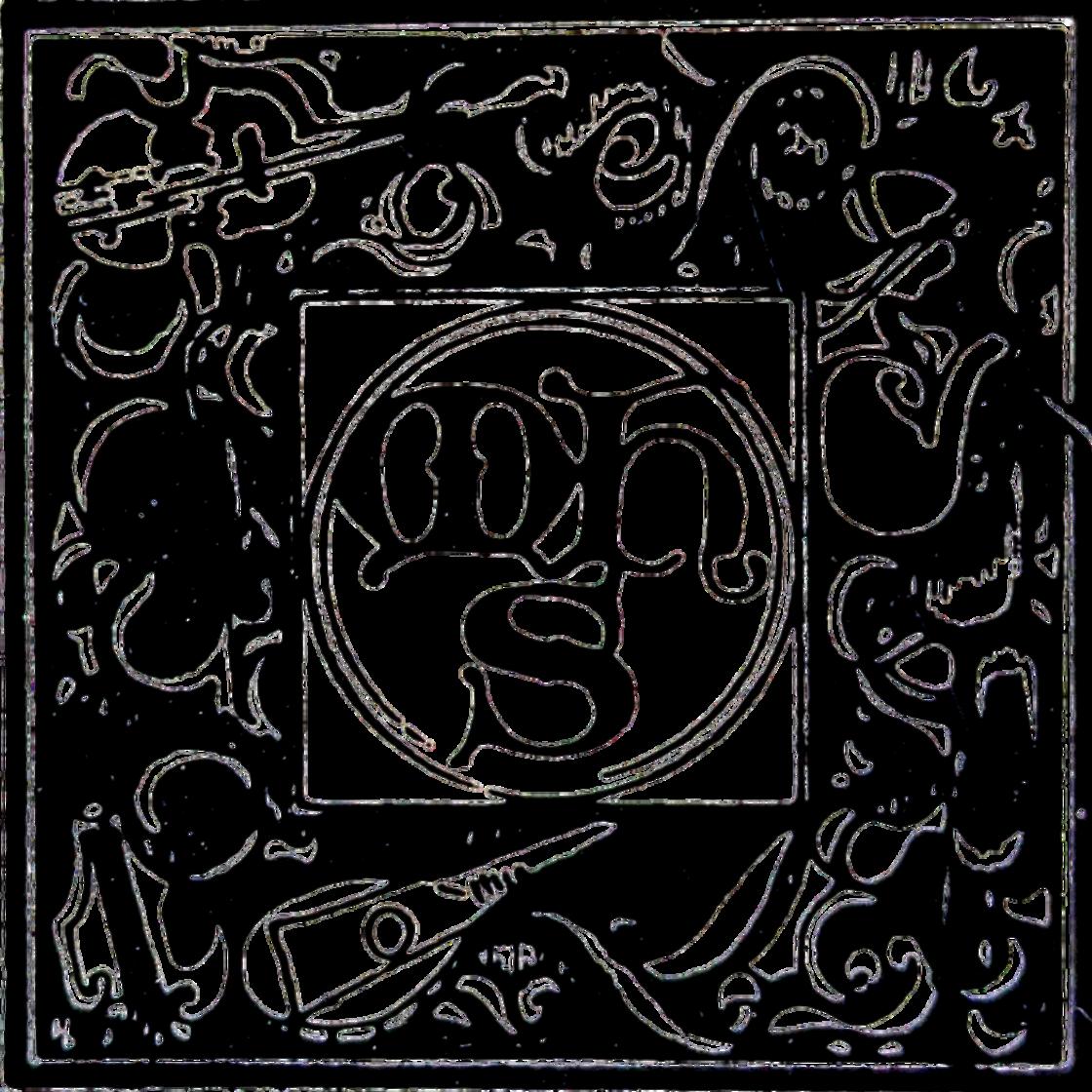
So
Quick, So Hot, So Mad
NEW YORK ENSEMBLE FOR EARLY MUSIC
[1] Whither runneth my sweetheart (John Bartlet)
[2] Will you buy a fine dog? (Thomas Morley)
[3] Think'st thou to seduce me then (Thomas Campian)
[4] Can she excuse my wrongs (John Dowland)
[5] Cease mine (thine) eyes (Thomas Morley)
[6] Giles Farnaby's Dream; His Rest (Giles Farnaby)
[7] Go to bed, sweet Muse (Robert Jones)
[8] Musing my own self all alone (David Melvill, collector)
[9] A toy: The dark is my delight (Anonymous)
[10] Of all the birds that I do know (John Bartlet)
[11] I pray you, good Mother (Thomas Ravenscroft, collector)
[12] Fantasia (Thomas Morley)
[13] I go before my darling (Thomas Morley)
[14] The Satyr's Masque (John Adson, collector)
[15] Pined I am and like to die (Thomas Campian)
[16]Peter's PleasureThe Second Part of Peter (Tobias Hume)
[17] If thou long'st so much to learn (Thomas Campian)
[18] Away, call back what you have said (William Corkine)
[19] The Carman's Whistle (William Byrd)
[20] A Bellman's Song (Maids to bed, and cover coal) (Thomas Ravenscroft)
[21] So quick, so hot, so mad (Thomas Campian)
[22] Sweet Kate (Robert Jones)
New York Ensemble for Early Music
Frederick Renz, Director
Johana Arnold, Soprano
Tina Chancey, Bass viol, treble viol, violin
Daniel Collins, Countertenor
David Hart, Flutes, recorders
Frederick Renz, Harpsichord
In contradiction to the commonplace that human nature is ever the same, the fact is that tastes in sexual humor are fleeting. It is difficult for us to put those tastes of different ages and cultures from our own into historical, social, or even personal perspective, since our view is clouded by the ever-changing attitudes of our own society and by our usually immutable individual prejudices. We frequently hear references, delivered perhaps with sly and knowing winks, to the Elizabethans' morally unfettered way of life, or to the naughtiness of their "ballads," or to "Shakespeare's bawdy." (The glossary to Eric Partridge's book by that title [New York: E. P. Dutton, 1960] will furnish the reader with good interpretations of some sexual metaphors and euphemisms of Elizabethan usage. It will also reveal, incidentally, subtle changes in society's attitudes since 1948, when the book was first written.)
In fact, there has seldom in the world been an age of cleaner minds than this golden age of English music and literature. The Elizabethans were simply, probably incomprehensibly to us, frank. There was no salacious interest in the mere mention of bodily parts -- after all, the codpiece was a
prominent part of most males' attire-and sexual functions were recognized generally, certainly by Shakespeare, as the complex metaphors of human relationships that they are. On the other hand, truly "bad" words (which were the same ones then as now) seldom found their way into print or public performance. How very different is this Elizabethan frankness from the scatological and guiltridden audacity of the Restoration in reaction to the Puritan restrictions of the Interregnum, or from the merciless sadism of certain courtly French literary genres in the thirteenth century!
As all readers of Shakespeare know, the Elizabethan sense of humor ran to the double-entendre, the pun. Although some of us still appreciate this sort of witticism, even the most avid 20th-century fanciers of puns do not slap their knees or dissolve into hysterical laughter at the best ones, as we presume the Elizabethans did. Our taste has changed. It is even possible that a great considered wit of that era might be driven from a modern cocktail party with groans and never be invited again. But still we can appreciate the fun of seeing through a veiled meaning or grasping an innuendo, and can
delight in metaphor and curious comparison.
So that the fun and delight may be all your own, I shall not presume to tell you what the songs on this record are about, or point out the thread that holds them all together. But some observations on the instrument called "virginals" might serve to stimulate your modern brain toward the Elizabethan turn of thought. It is quite clear, not just from the title of Tobias Hume's "toys" (see page 7), but from thousands of metaphorical allusions, that for the Elizabethans, music making itself, especially upon instruments, was a parallel to sexual activity. (At that time, practically everyone did it.) A punning mind could not fail, even though the word "virginals" stems from virga, a stick, and not virgo, a virgin, to draw to it associations with desirable young girls, or else to the Virgin Queen. (The word is properly plural because the instrument consists of a row, or "paire," of little sticks.) "To play upon virginals" could mean then "to seduce a maiden" or "to manipulate Elizabeth politically" by flattery or by a proposal of marriage.
most famous. Legal and church records, or university records of the granting of degrees, may establish the presence of a certain person in a certain place, but of course, they cannot give us insight into his personality or state of mind. The best sources we have are the musical publications themselves, which are most often dated, and nearly always contain samples of the composers' own literary styles in the form of dedicatory letters or introductory apologies. Frequently a dedication will provide clues to a musician's history or associations.
Biographical information about Elizabethan and Jacobean composers is often frustratingly incomplete. Birth dates are exceedingly difficult to determine, and death dates are ascertainable usually only for the,
For two reasons Thomas Morley is a bit of an exception to this state of affairs. In 1597 he wrote the definitive theoretical work of the period, A Plaine and Easie Introduction to Practicall Musicke (available in modern editions), and from 1598 to his death in 1603 he held the royal patent for the publication of music and music paper, which gave him a tremendous amount of well-deserved power and influence in the musical world. He had studied mathematics as well as music with William Byrd; he was a good friend of the madrigalist Thomas Weelkes; and despite ill health, he probably was acquainted with every composer, writer and performer active in London in the late sixteenth century, including Shakespeare (the song "It was a lover and his lass" in As You Like It is his).
He wrote and arranged music for a wide variety of forces: voice with lute, vocal ensembles of two to five voices, instrumental duo or trio (instruments unspecified) and mixed consort.
The personality of the physician Thomas Campian sparkles brilliantly through his music and poetry and critical writings, which arts his friend Philip Rosseter called "the superfluous blossoms of his deeper studies." Perhaps stimulated by experiences abroad, Campian was consumedly interested in establishing specifically English modes of speech and melody, just as he felt had recently been done in French and in Italian. "In these English Ayres I have chiefely aymed to couple my Words and Notes lovingly together" (note the straightforward sexual metaphor) "which will be much for him to doe that hath not the power over both. The light of this will best appeare to him who hath pays'd (i.e., weighed) our Monasyllables and Syllables combined, both which are so loaded with Consonants as they will hardly keepe company with swift Notes, or give the Vowell convenient liberty." Campian's efforts were saliently successful; it would be hard to point to another group of songs, from any period, whose words and music are so happily wedded. All his surviving music is for lute and voice, with optional instruments and/or vocal parts.
John Dowland was the most brilliant virtuoso lutenist of his, probably of any, age. He was also a most musicianly composer, a scholar, theoretician, and translator, and if he was not the originator of the idea of the solo song, he certainly established the lute song as a genre on equal footing with the madrigal or motet. He traveled widely and was very richly rewarded on the Continent, if not at home in England (the prevalent assumption that he was Irish most probably is untrue.) He always was able, apparently, to spend whatever money he had, and we can observe a certain extravagance in his compositions for solo lute, or in his styling himself as a melancholic: "semper Dowland, semper dolens." His personality expressed in his writings seems sometimes more than a little sour; the acid taste of the words to "Can she excuse" could well point to Dowland as their author.
A curious battle, taken quite seriously by its principals, was waged in the prefatory pages of their respective works between Dowland and Tobias Hume. Hume was an unemployed mercenary soldier, an amateur musician by all standards, who held that the "Gambo Violl" could "with ease yeelde full various and as devicefull Musicke as the
Lute." Dowland, humorlessly, was offended at this assertion that by it "the best and principal! Instruments have been abased, but especially the Lute by name," and that no "gallant young Lutenists" had come forward in "defence of their Lute profession" in the seven years since the challenge was made. Clearly Tobias Hume was a bit mad (he suffered more and more from mental delusions at the end of his life); Dowland need not have deemed the challenge a threat to his own unrivaled musical supremacy. The fanciful titles to Hume's little pieces (properly called "toys") include "Tickell, Tickell," "She Loves it Well," "Now I come," "Hit it in the Middle," "Touch me Sweetly," and "My Mistresse little thing."
The long-lived and productive William Byrd, who outlasted Morley his student by twenty years, was certainly the greatest of all English composers before Purcell, "a Father of Musick," in Morley's words, "never without reverence to be named of the Musicians." Unlike most of the composers described here, he was in no sort a lutenist, but wrote upwards of 140 pieces for virginals, in addition to his volumes of madrigals, Masses, motets, viol consorts, and "Songs of Sundrie Natures." It does
appear that his fame and dignity as a musical artist spared him from being persecuted as a Catholic, but he was capable of writing music for both Latin and English liturgies with equal depth and sincerity.
Next to nothing is known of either Giles Farnaby or Robert Jones, although each was a prolific composer within his own genre: fifty pieces in the Fitzwilliam Virginal Book are attributed to Farnaby, and Jones published five books containing about 100 lute songs, at least one of which was familiar enough to find its way into a jest in Twelfth Night. John Bartlet and William Corkine are yet more obscure than these, known only by their books of airs.
Of the collectors and publishers represented in this recording, John Adson, Thomas Ravenscroft and David Melvill, we know little. Ravenscroft, who first brought out "Three Blind Mice" in 1609, in particular was captivated by the rustic or lower-class flavor of the "catch," or round, in contrast to the courtly "ayre," and, for this reason, he deliberately selected and emphasized its bawdier elements. Thus he began the association, fully realized in the later rounds of Purcell and his contemporaries, of the catch, like the modern limerick, with the filthy.
-Lucy Cross
Produced and Recorded by Dr. Frederick J. Bashour
Digitally remastered by Dr. Frederick J. Bashour,
Dulay Digital Music
Recorded at the St. James Chapel of the Cathedral of St. John the Divine.

